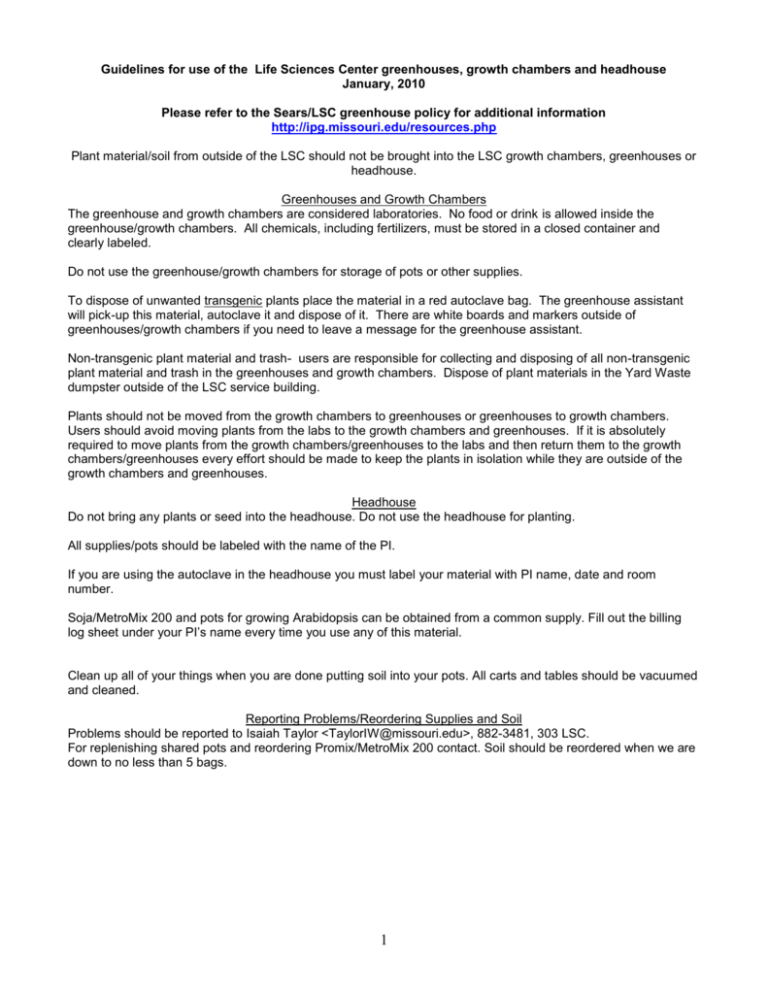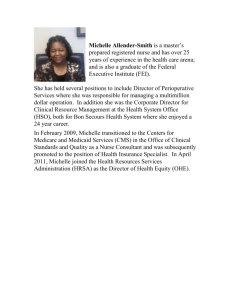Section III-D-5
advertisement

Guidelines for use of the Life Sciences Center greenhouses, growth chambers and headhouse January, 2010 Please refer to the Sears/LSC greenhouse policy for additional information http://ipg.missouri.edu/resources.php Plant material/soil from outside of the LSC should not be brought into the LSC growth chambers, greenhouses or headhouse. Greenhouses and Growth Chambers The greenhouse and growth chambers are considered laboratories. No food or drink is allowed inside the greenhouse/growth chambers. All chemicals, including fertilizers, must be stored in a closed container and clearly labeled. Do not use the greenhouse/growth chambers for storage of pots or other supplies. To dispose of unwanted transgenic plants place the material in a red autoclave bag. The greenhouse assistant will pick-up this material, autoclave it and dispose of it. There are white boards and markers outside of greenhouses/growth chambers if you need to leave a message for the greenhouse assistant. Non-transgenic plant material and trash- users are responsible for collecting and disposing of all non-transgenic plant material and trash in the greenhouses and growth chambers. Dispose of plant materials in the Yard Waste dumpster outside of the LSC service building. Plants should not be moved from the growth chambers to greenhouses or greenhouses to growth chambers. Users should avoid moving plants from the labs to the growth chambers and greenhouses. If it is absolutely required to move plants from the growth chambers/greenhouses to the labs and then return them to the growth chambers/greenhouses every effort should be made to keep the plants in isolation while they are outside of the growth chambers and greenhouses. Headhouse Do not bring any plants or seed into the headhouse. Do not use the headhouse for planting. All supplies/pots should be labeled with the name of the PI. If you are using the autoclave in the headhouse you must label your material with PI name, date and room number. Soja/MetroMix 200 and pots for growing Arabidopsis can be obtained from a common supply. Fill out the billing log sheet under your PI’s name every time you use any of this material. Clean up all of your things when you are done putting soil into your pots. All carts and tables should be vacuumed and cleaned. Reporting Problems/Reordering Supplies and Soil Problems should be reported to Isaiah Taylor <TaylorIW@missouri.edu>, 882-3481, 303 LSC. For replenishing shared pots and reordering Promix/MetroMix 200 contact. Soil should be reordered when we are down to no less than 5 bags. 1 PESTICIDE POLICY 1. Everyone who works in the greenhouses or growth chambers is required to go through Worker Protection Training with Michelle Brooks <BrooksM@missouri.edu>. Michelle will also go over the pesticide procedures with you then. If you hire new people, make sure they contact me to set up a time to do this training. It only takes about 45 minutes at the most. 2. It is up to you, the user, to keep an eye on your plants and submit a pesticide application request in writing to Michelle when you notice a problem. The best way to do that is to email "Brooks, Michelle A." <BrooksM@missouri.edu> with your request and the specific location you are requesting treatment for. Once Michelle receives a request, her crew scouts the room to confirm which specific pests are present and she will schedule the initial application. Michelle does her best to get the room treated as soon as possible but depending on when she receives your request and the severity of the problems in all the rooms she receives requests for, it may not be sprayed immediately. For example, if you turn in a request at 3:00 on Tuesday it will probably not get treated until Thursday. They only spray on Tuesday and Thursday evenings after 4:30 pm so that you have time to get your work done during the day and the greenhouse will only be locked overnight. Warning signs will be posted on the door for the restricted entry interval during which time, the room will be locked. In the morning, they take down the signs and unlock the door. The green sign stating when and what was sprayed will be posted in the hallway for 30 days so you can go back and look to see what was done in your room. Beyond 30 days, you need to contact Michelle for that information. 3. After the initial application, they continue to scout the room and do follow-up treatments as needed. As required by most pesticide labels, spray intervals are at a minimum 7-10 days apart. 4. If you are taking data or something that you have to have access to your greenhouse on certain Tuesday or Thursday evenings, you need to let Michelle know of that kind of stuff so she knowa they can’t spray those evenings. If for some reason there are plants that you do not want sprayed, you need to let Michelle know that too, however, keep in mind that if the entire room is infested, she cannot get control of the pest if there are infested plants that she can’t spray. 5. Spray requests are good for 30 days. Usually in that time, with 1-3 sprays, she can get the pest population under control. And they will continue to scout and monitor that room for those 30 days. If another problem comes up a couple months later, you have to submit a new request. 6. Keep in mind that you should submit a request when you first notice a problem. If the plants are severely infested, it is much harder to control plus the chances are much greater that the pest can spread to neighboring rooms. On the other hand, if you see one thrips and turn in a request, if Michelle can’t find the thrips when she scouts, the room will not be sprayed. Most of her pesticides are contact pesticides so it doesn’t do any good to spray if the pest is not actually there. Michelle will scout the room for the next couple of weeks and if she finds thrips she will begin treatments. There are also lots of restrictions on how many times per year that Micelle can spray certain pesticides so she has to be careful to make sure the pest problem is there before she can spray. 2 7. Those of you who work in both growth chambers and greenhouses should always go to the growth chambers before you go to the greenhouses and never move plants from the greenhouse to the growth chamber room. It’s very easy to carry pests on plants or yourself from the greenhouses to the chambers. Michelle also recommends that you do not wear yellow clothing in greenhouses. Whiteflies are very attracted to yellow clothes and will land on you and be moved from one place to another. 8. Michelle's crew can only apply pesticides in the greenhouses and in the growth chamber room in the basement. Any growth chambers located in labs are the responsibility of the lab personnel. 9. Cleanliness in your greenhouse can help to keep pest populations under control. Any build-up of media or plant debris on benches or on the floor are places that harbor pests. Stacks of pots being stored in the greenhouse can harbor pests. There are brooms in the hallway and Michelle has a shop vac and power washer that can be checked out for use by emailing Michelle or Rich Wilman "Wilman, Richard" <wilmanri@missouri.edu>. If there is any time that a growth chamber or greenhouse can be emptied out and thoroughly cleaned it will help. 10. Please also keep in mind that when Michelle's crew sprays a greenhouse or growth chamber, complete eradication is nearly impossible. There are just no pesticides that are relatively safe for people to handle that completely kill everything. Because most of them are contact sprays it’s just very hard to hit every tiny pest so they do the best they can to kill as many as possible. 3








